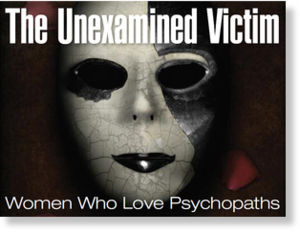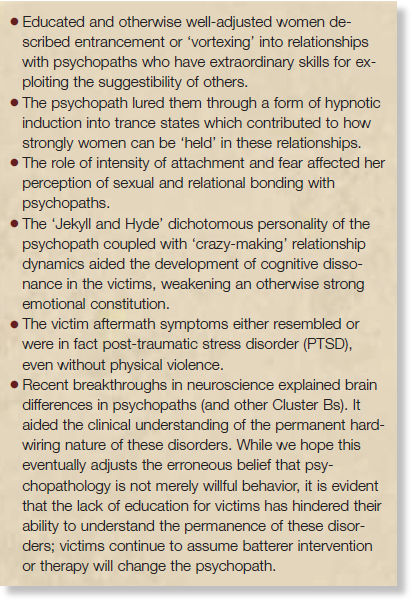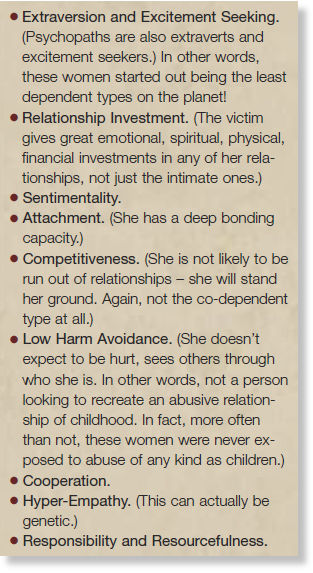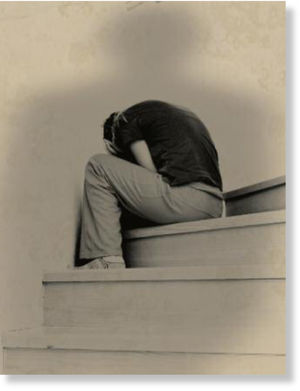By Sandra L. Brown
[This article first appeared in Issue 13 of The Dot Connector Magazine]
“We can’t prevent what we don’t identify, we can’t treat what we don’t diagnose. And we can’t teach how to spot them unless we understand pathology ourselves.”
Millions of dollars have been spent researching and writing about psychopaths while almost nothing has been spent, either in terms of time or money, on the profoundly disturbing byproduct of psychopathy – its victims. Since male psychopaths outnumber the female variety by about 3 or 4 to 1, I’ll be talking mainly about female victims of male psychopaths in this article.
Despite the fact that psychopaths devastate everyone in their path including the women and children who love them, why have clinicians not seen fit to study and write about the single most obvious source of insight into this issue: the survivors of intimate relationships with psychopaths? The study of any disease involves carefully collecting and examining its symptoms, and psychopathy is definitely a societal disease. Even our legal system gathers information about criminals by taking testimony from on-site, first hand witnesses. So again, I ask: why is there no clinical material about – much less interest in – the psychopath’s partner?
I think that one answer is: therapists don’t recognize her as a victim of psychopathy because they usually don’t recognize him as a psychopath! On the rare occasion when a psychopath’s victim is identified, she is lumped together with more typical domestic violence survivors; or labeled as codependent, a relationship/sex addict, and/or assumed to be suffering dependent personality-disorder. These inaccurate and often biased explanations of pathological love relationships have neither helped victims find specific treatment for their unique relationship dynamics and aftermath symptoms, nor have they contributed (as they could) to our knowledge of psychopathy itself. It’s a travesty within the clinical profession that the victims are not more readily identified or better understood and that this rich source of vital information has not been mined.
I came into the field of pathology through the back door – I was not looking to work with Cluster B relationships (i.e., with narcissistic, antisocial, histrionic, and borderline personality disorders; personality disorders are grouped into one of three clusters based on common characteristics) – I was just trying to offer counseling to victims of crime. However, going through that door led me into a whole career within the field of psychopathology and now, after 20 years of ‘treating’ personality-disordered people, I have gained a new appreciation for the depth of permanent devastation caused by what Otto Kernberg called the “dangerous and severe personality disorders.” These severe disorders affect not only the sufferer, but family members, partners, friends, children, and even the therapists themselves. I continue to be overwhelmed by the fact that the therapeutic progress of those with personality disorders is measured in millimeters, while the devastation they leave behind is measured in miles.
After years of working with the disordered, my focus began to shift; I realized that my time and energy would be far more fruitfully spent helping those who didn’t recognize the oncoming pathological in their lane of life. The problem was clear: women became victims because they didn’t recognize the difference between normal personality diversity and the signs and symptoms of pathology. Despite the fact that most personality disordered individuals can hide for some period of time behind a ‘mask of sanity’, there are signs and symptoms that the non-clinician can learn about and thereby avoid some of the most devastating life events known to our society. I noticed the ‘dangerous man’ experiences from which women were healing were largely due to two types of pathology: narcissists and the whole antisocial end of the pathology spectrum, which includes antisocial personality disorders, sociopaths and psychopaths. And so, I initiated psychopathology education for the community-at-large. Through one of my earlier books How to Spot a Dangerous Man Before You Get Involved I focused on the effects that Cluster B personality disorders can have on a relationship, coining the term ‘relationships of inevitable harm’.
As I counseled victims of the personality disordered, learning from them things that made my hair stand on end, I wondered why others had not bothered to study the persons who were exposed to the most dangerous relationships on the planet! If the field of violence prevention had been around since the 1970s, why wasn’t this pool of potential homicide-risk victims better identified for prevention or treatment at the very least? Why had no one ever thought to collect the precious data they – and they alone – could provide?
As one of the first therapists to extensively study the clinical aspects of the partners of psychopaths, I was fascinated to discover that these women were remarkably similar in personality traits. Their stories of their relationship dynamics were comparable, and their aftermath symptoms identical. At the same time, despite the therapeutic mislabeling mentioned above, and the societal misunderstanding of them, women who loved psychopaths didn’t turn out to fit any of those labels! It was ironic that there was so much similarity between all of them, but none of it had anything to do with the labels which had been assigned to them!
The Institute, which I founded, conducted an in-depth study of over 75 women worldwide (and has continued to study many more women since then). This intensive survey collected data, relationship stories, histories, symptoms, temperament traits, and characteristic behaviors along with the dynamics of their interactions with pathological partners. This victim-based research brought into sharp focus the long-missing issue of their unusual relationship dynamics and their often masked aftermath of symptomatology. (For more information read Women Who Love Psychopaths: Inside the Relationships of Inevitable Harm with Psychopaths, Sociopaths & Narcissists. 2nd ed. Sandra L. Brown, M.A.). It also highlighted some unusual aspects that only psychopaths could bring to, and perpetrate in, an intimate relationship. This was shocking insight into the dynamics of the psychopathic lifestyle.
Here is what was discovered:
The seminal aspect of the research was in detecting these women’s unique and astounding elevated ‘super traits’ of temperament, personality strengths and weaknesses. These proved to be an amazingly compatible match for the strengths and weaknesses of a psychopath and brought a natural ‘balance’ to the honeymoon aspects of the relationship.
While the uncovering of her innate traits and conditioned behaviors explained much about this dangerous relationship and has brought huge intellectual and emotional relief to the victims, it does not seem to have gone very far in modifying the public misperceptions about psychopaths or their victims. On a recent radio show, after describing the huge elevation of some of the victim’s temperament traits and explaining how it could affect her patterns of selection and even tolerance in these relationships, the host said, “That’s a crock of crap! You’re telling me that a few temperament traits can do that? I don’t believe it. She picked him, she stayed, she needs to own it and she was probably abused as a child.” These simplistic answers are what have been, and continue to be, at the core of the abysmal lack of public psychopathology education.
As mentioned, my research has revealed that women who love psychopaths (and other Cluster B personality disordered individuals) possess rather unique and extraordinary ‘super traits’ of temperament that make them the perfect target/victim of the psychopath. While the following does not cover all of her traits, these were the ones most highly elevated and were thus likely contributing factors:
I think that we can all agree that these sound like outstanding women in all respects! These stellar qualities don’t look like a problem at first glance, but some of these traits were measured in the range of 97% higher than average, proving that even too much of a good thing can be bad. What happens when you put all this together:
Too much empathy + high bonding + high sentimentality + and low harm avoidance?
You get inevitable harm. You get fabulous women who love deeply, who have a big heart, who get much out of their relationships and who tend to trust openly because they believe that everyone on the planet is as good and decent and loving as they are. What’s more, their super-traits make them able to hold to that belief in the face of some of the most horrifying evidence to the contrary imaginable.
While finding these kinds of off-the-chart trait combinations sounds foreboding, it is actually good news. We can’t prevent what we don’t identify. We can’t treat what we don’t diagnose. And we can’t teach how to spot them unless we understand pathology ourselves. With this new understanding we have the ability and possibility to use this information to develop targeted and appropriate survivor treatment programs and – more importantly – to design Public Psychopathy Education targeted at those that are most at risk for developing or sustaining relationships with individuals of the psychopathic ilk.
Since the first printing of Women Who Love Psychopaths, I have spent over a year using this specific information and developing new approaches in our treatment programs. I designed the programs exclusively for women emerging from relationships with psychopathic men. After treating dozens of clients I have learned a great deal about the unique aspects of the destructive consequences that these women experience in the aftermath of these relationships. I have added that new data related to these findings later in the book.
Both my understanding and my clients’ intimate first-hand knowledge of psychopathy are different from many conventional and even clinical writings about the psychopath. Considering how the women came to know what they do know, it should be different. My understanding about the disorder has grown out of my unique experiences treating the psychopath’s victims, who have shared their personal life-destroying lessons about their encounters. When you approach the subject of psychopathy through the outcome of victimization, the view and insights are wider and deeper.
My perspective may differ from other psychopathy researchers who work primarily with criminal psychopaths in the prison system or those researchers who work in laboratories, as well as from instructors in academia who teach about psychopathology. In most of those cases, the only psychopathic subjects available for study or report are those who were caught or incarcerated. In the cases in this book, the psychopaths are primarily not, and have not been, incarcerated. They are what you might call ‘successful psychopaths’.
This factor highlights one difference in this book’s approach. I based the psychopath profiles on information provided by their intimate partners – not through standardized research approaches which depend, to a great extent, on ‘self-report’ by the psychopaths themselves. This is problematical at best since lying is one of the chief characteristics of the psychopath. The women answered detailed questions about the psychopath’s behaviors and their unique relationship dynamics. Experience taught me that you can learn a great deal from how victims and witnesses describe the psychopath’s behaviors. Words and actions, closely observed over long periods of time, provide a rich source of data from which to infer the psychopath’s mental landscape.
I wrote this book to help the psychopath’s victims understand their unique and unprecedented at-risk status – past, present, and future. I hope the book will teach them how to safeguard themselves from other predators and prevent the devastation psychopathy causes. Over 20 years of providing counseling, I have sadly seen hundreds (if not thousands) of lives destroyed by varying levels of mixed pathology and psychopathy. This growing global pathology stands as one of the primary public mental health issues facing our world today simply because of the number of victims it will inevitably create – because that’s what psychopathy ‘does.’
More importantly, I believe this book has begun a process in the US towards Public Psychopathy Education. I believe the way to prevent psychopathic destruction within society is through public awareness education. Education can help women make better parenting choices by explaining:
- the risk of psychopathic fathers passing their disorders on genetically
- how psychopathic fathers emotionally damage the children they parent
Pathological parenting always leaves its brutal and twisted world view imprinted upon impressionable souls.
To impact the public’s future knowledge, women must know what psychopathic traits look like in men. They can’t understand a psychopath until they learn what pathology in the psychopath looks like, acts like, and hides like.
If you have read Women Who Love Psychopaths, please be an ‘Ambassador for Change’ in your community by teaching youth and adults what you learned in the book. Help by disseminating information through a Public Psychopathy Education Project in your community or by running support groups for those leaving pathological relationships. The Institute offers personal training to coaches, counselors, and therapists who want to offer Pathological Love Relationship groups or support in their communities.
Also, why not donate a copy to your local women’s organization, Domestic Violence Program, Rape Crisis Center, college campus, or any other women’s organization that serves at-risk women? Or, bring a Pathological Relationship workshop to your community and change one woman at a time.
Our goal is ‘Each One, Teach One.‘
If we all do a little, together we can do a lot.
For more information visit: saferelationshipsmagazine.com
About the author:
Sandra L. Brown, M.A., CEO of The Institute for Relational Harm Reduction & Public Pathology Education is a psychopathologist, lecturer, and author. Her books include the award-winning Women Who Love Psychopaths, How to Spot a Dangerous Man Before You Get Involved, and Counseling Victims of Violence: A Handbook for Helping Professionals.
Sandra is recognized for her pioneering work on women’s issues related to relational harm with personality-disordered partners. She specializes in the development of Pathological Love Relationship clinical training and survivor support services. Her books, CDs, DVDs, and other training materials have been used as curriculum in drug rehab programs, women’s organizations, women’s jail and prison programs, school and college-based programs, inner city projects, various psychology and sociology programs and distributed in almost every country of the world. Her previous work included the founding and directing of Bridgework Counseling Center, a multi-faceted mental health treatment center and one of the country’s first long-term residential programs for women with Dissociative Identity Disorder. She was also a pathologist in a Woman’s Trauma Inpatient Hospital Program.
Sandra currently writes for several large women’s websites, Psychology Today, Times Up! Blog, and The Institute’s Safe Relationships Magazine. She is a frequently interviewed on radio and TV about pathology in relationships. Her next project is a book on cognitive dissonance as a response to pathological love relationships.






